
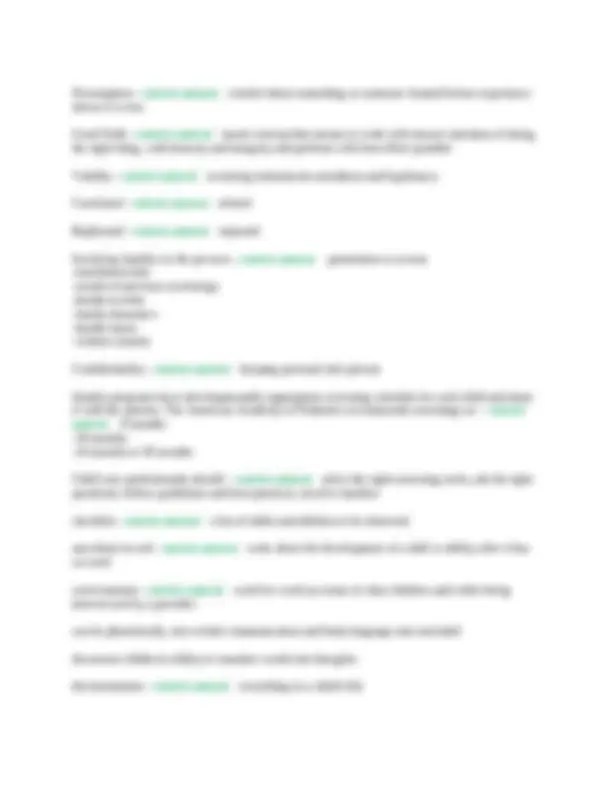
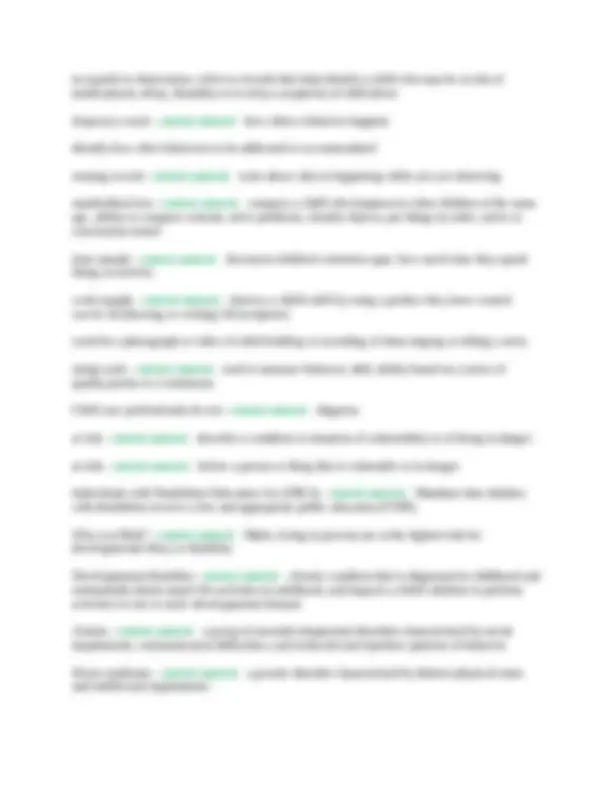

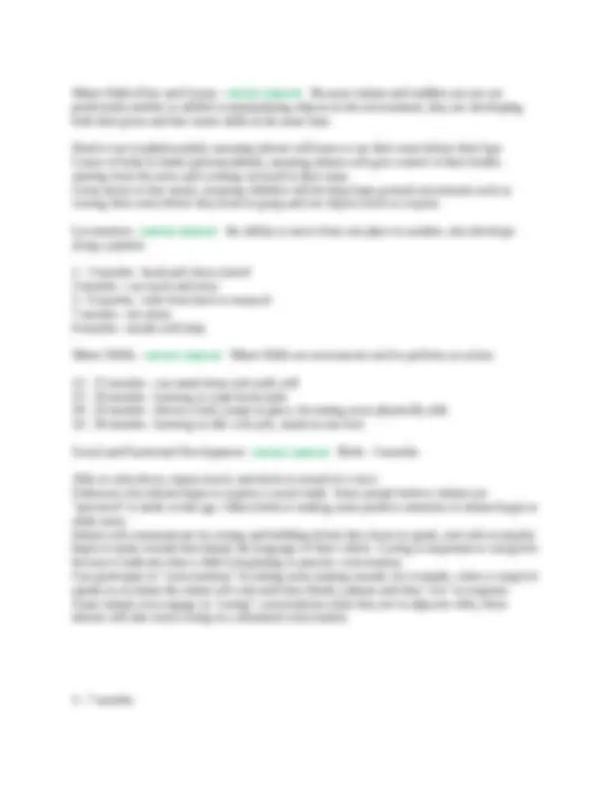
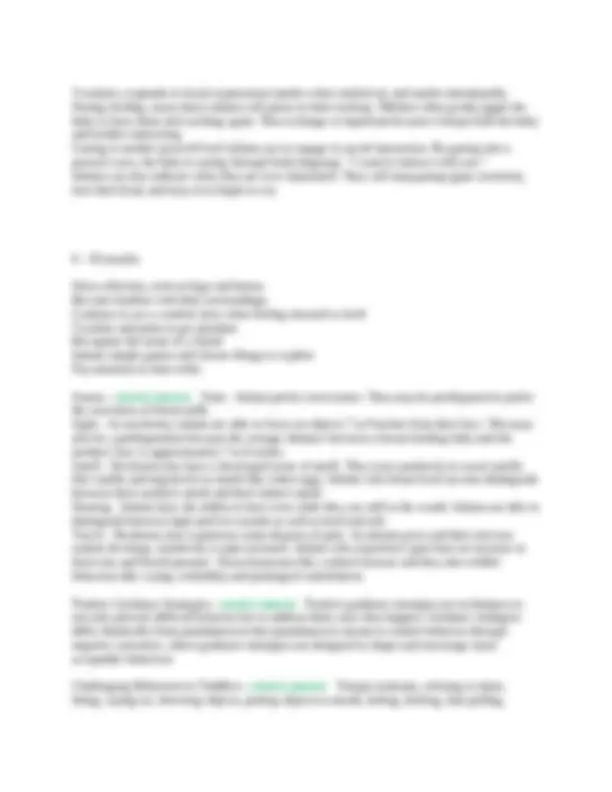
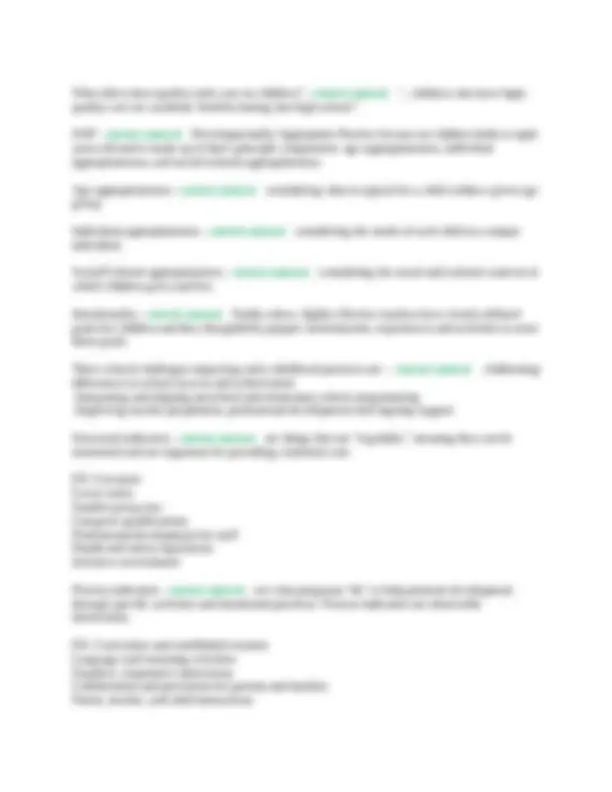
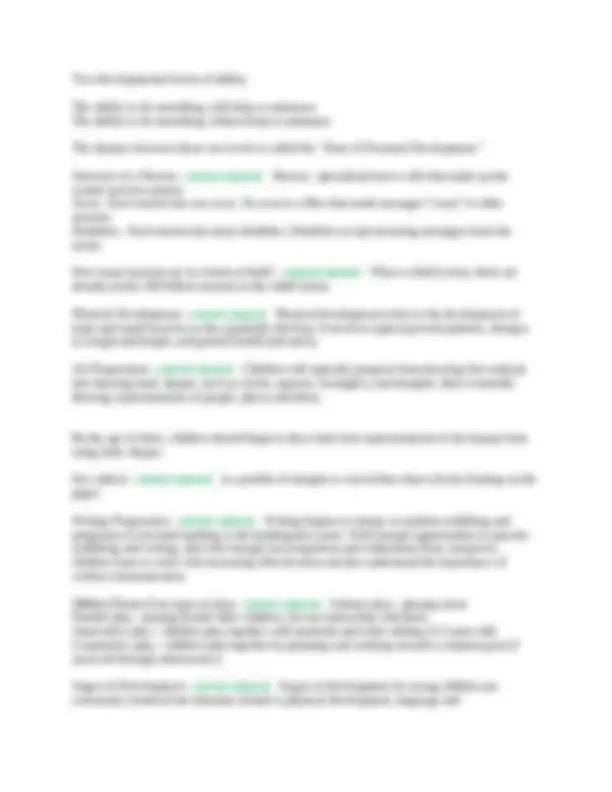
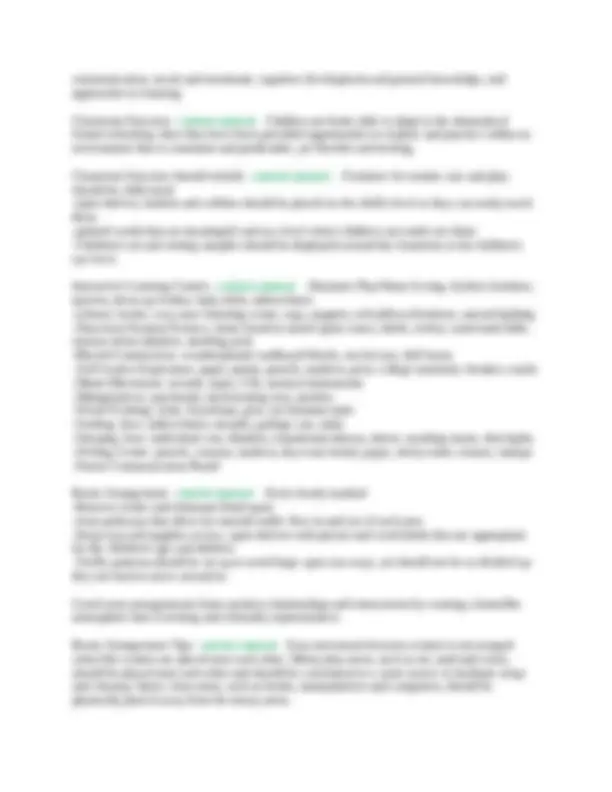
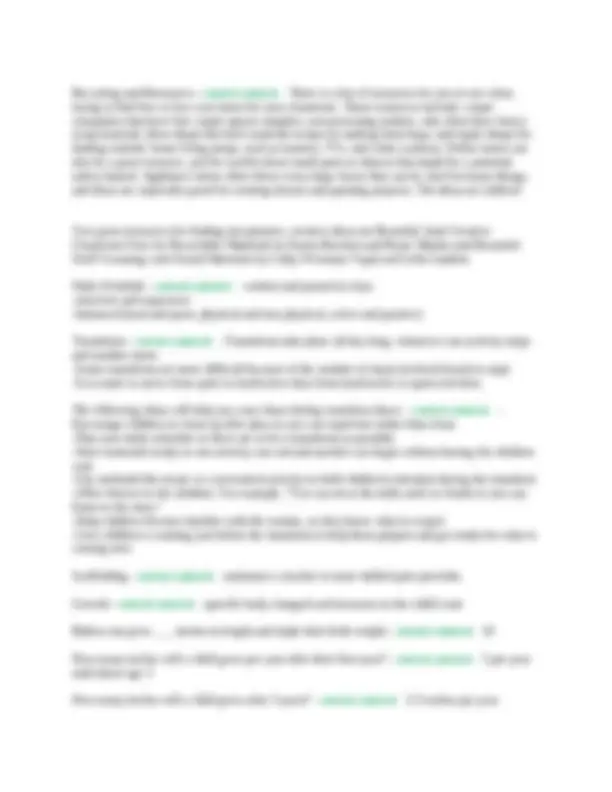
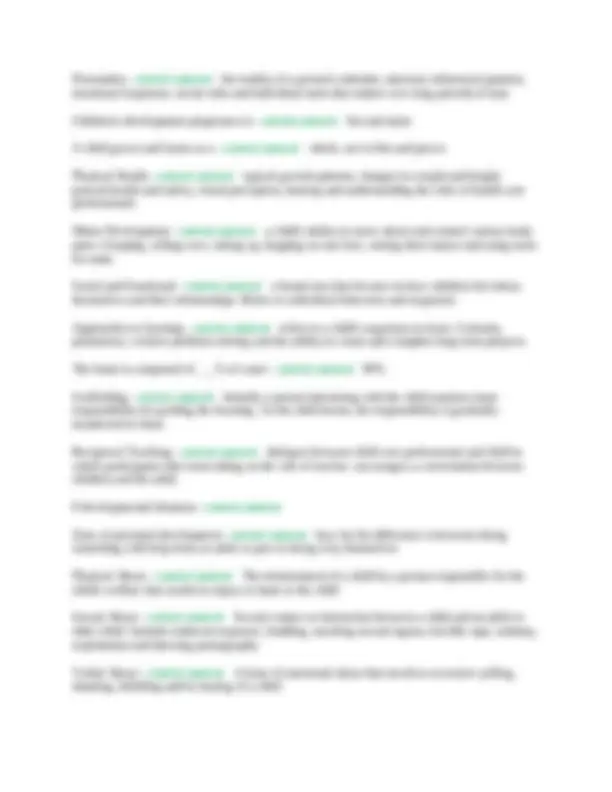
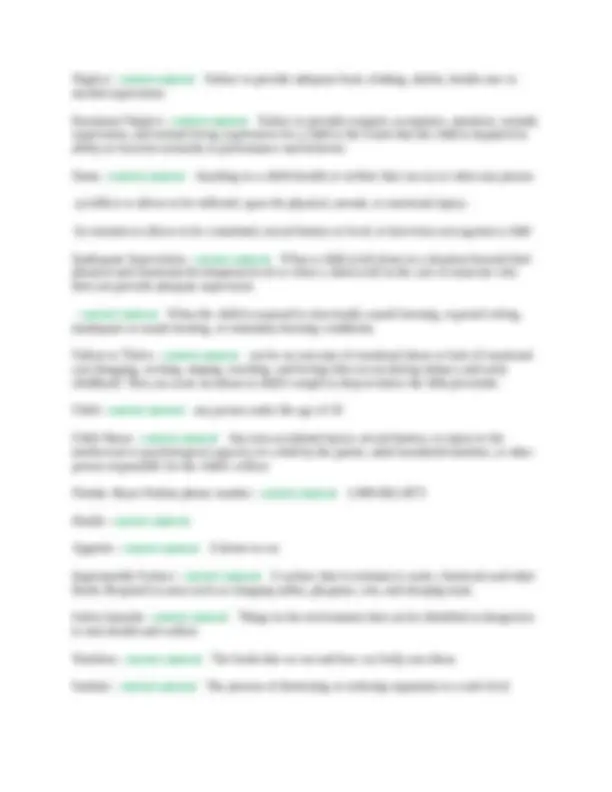
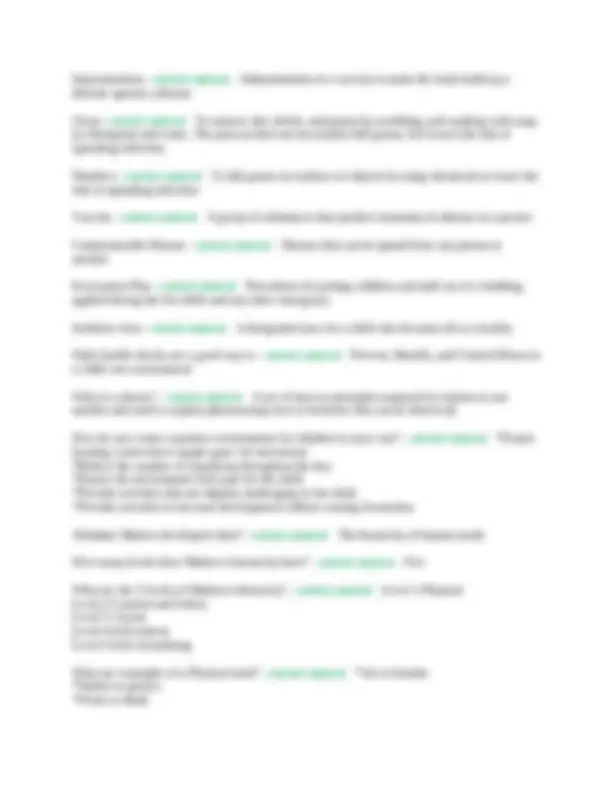


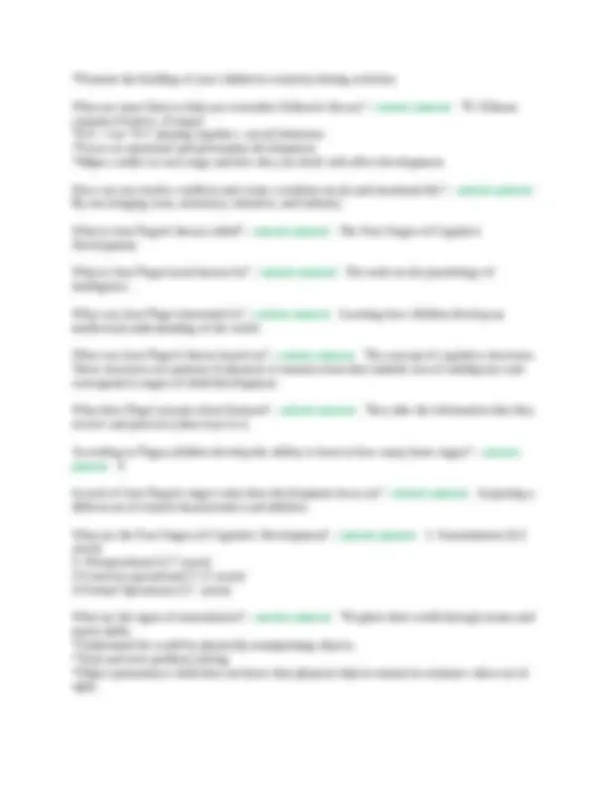
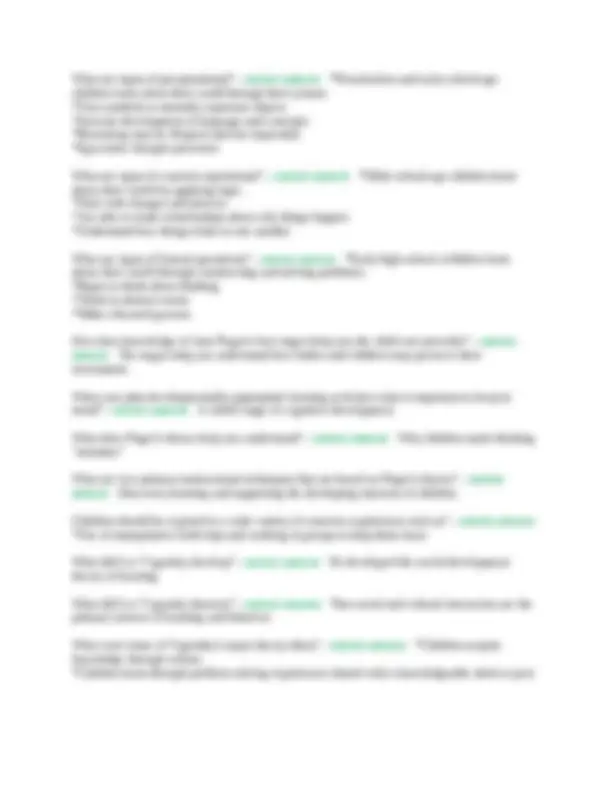

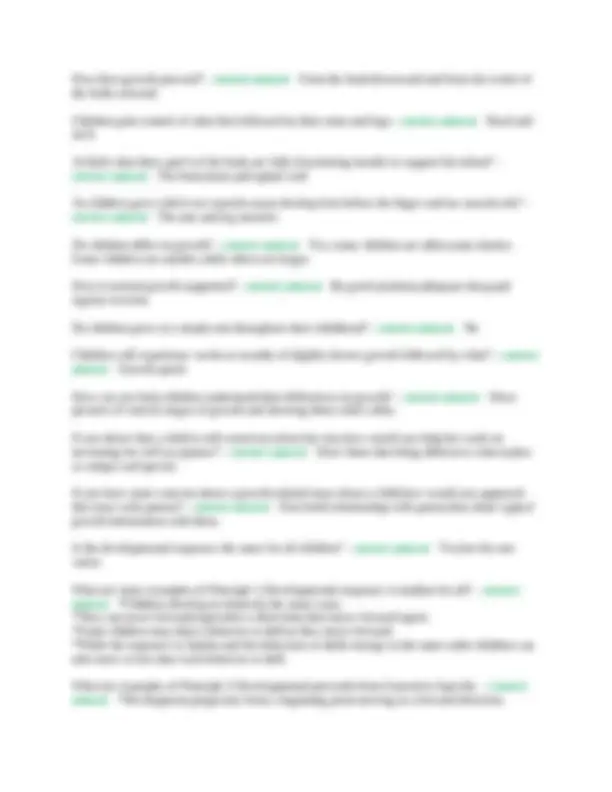

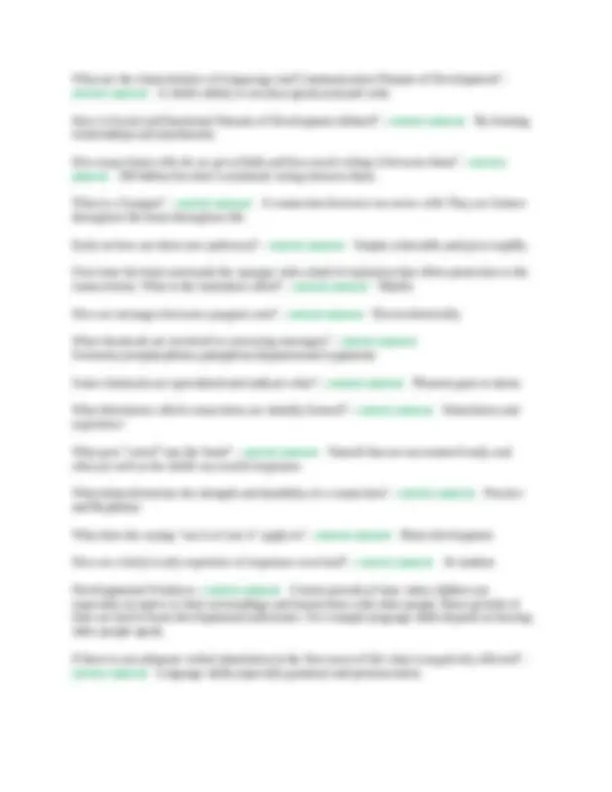
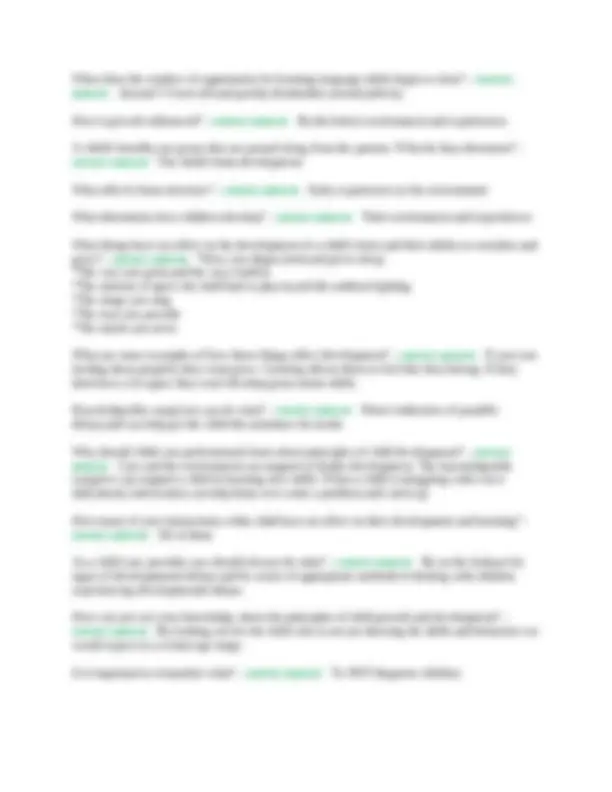
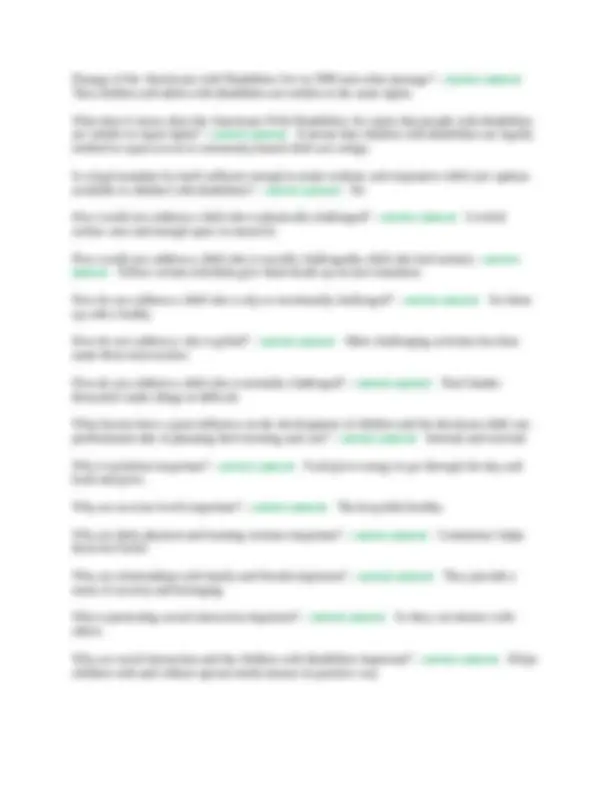
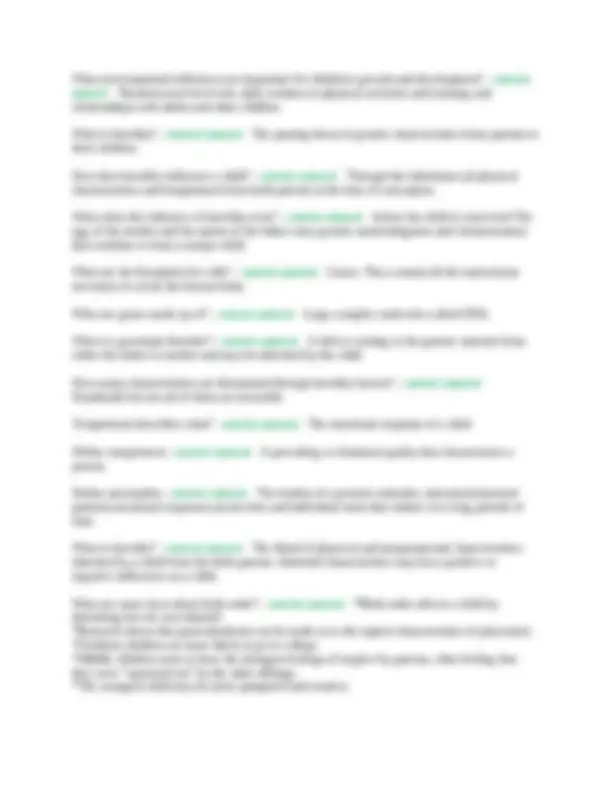
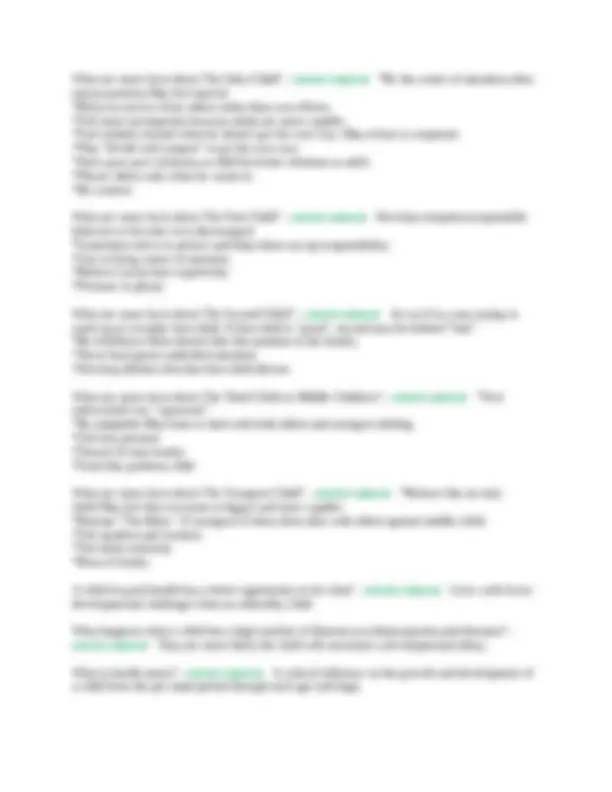
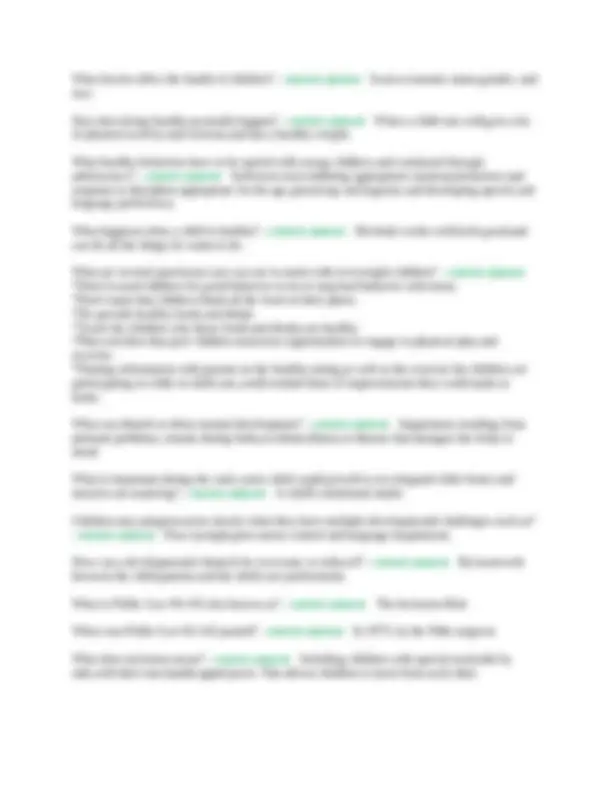
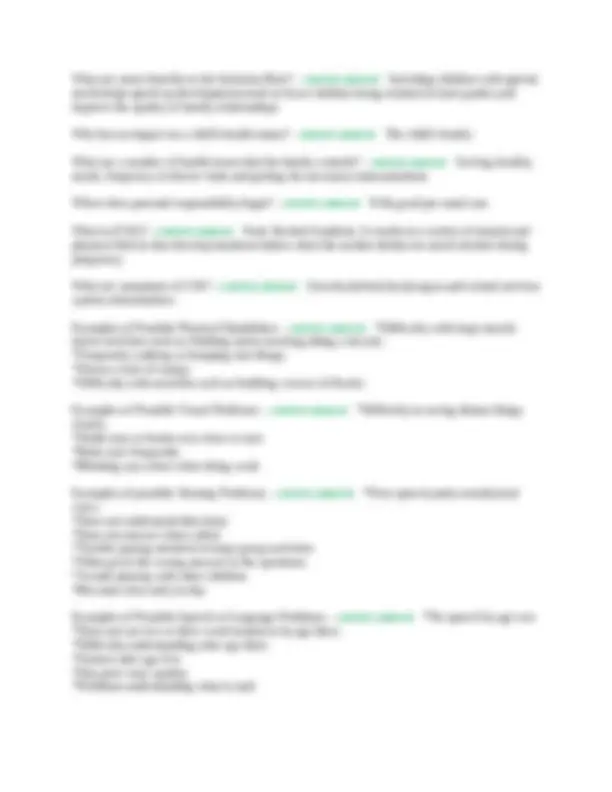
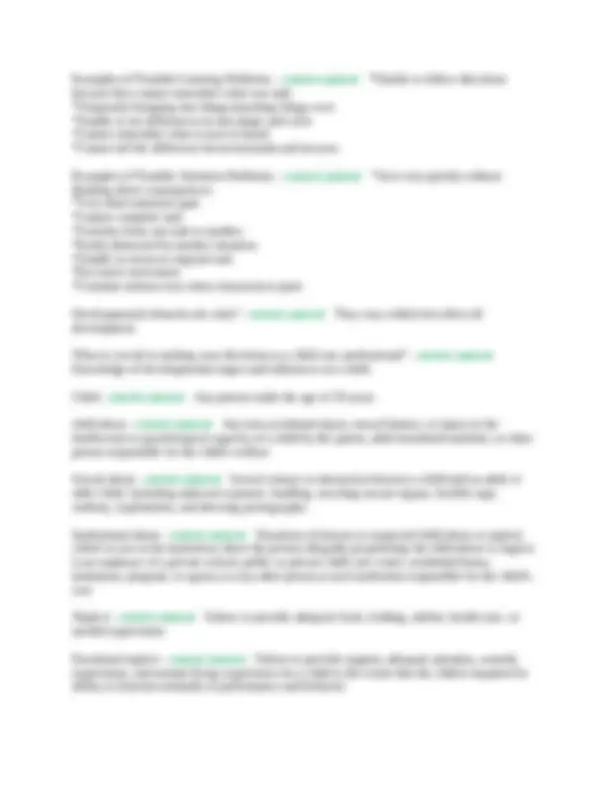
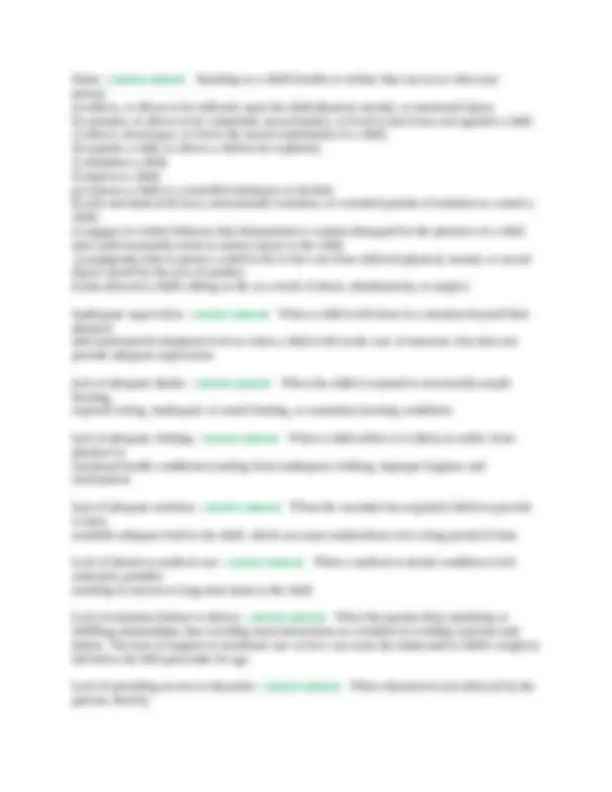
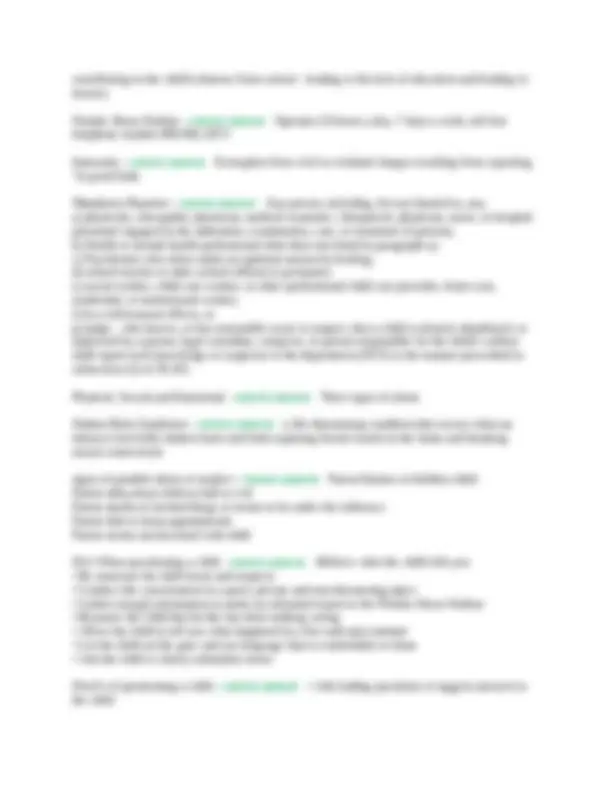
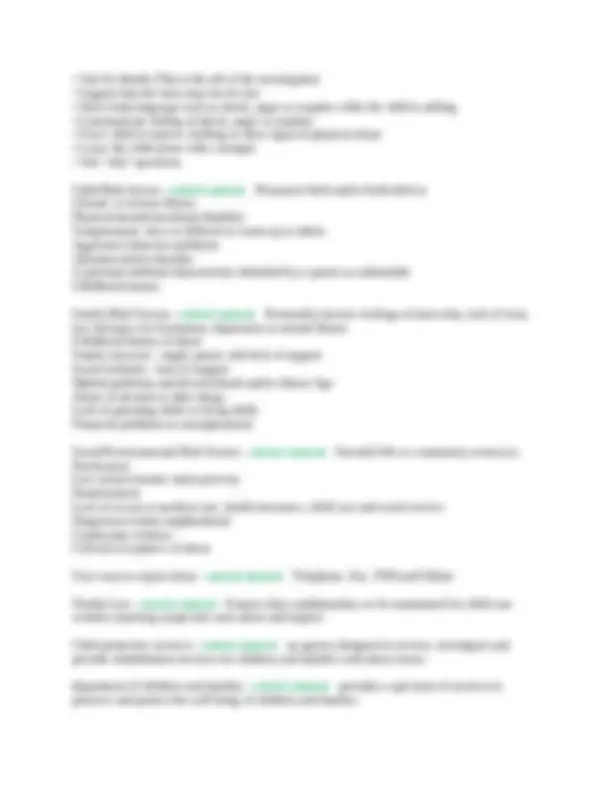
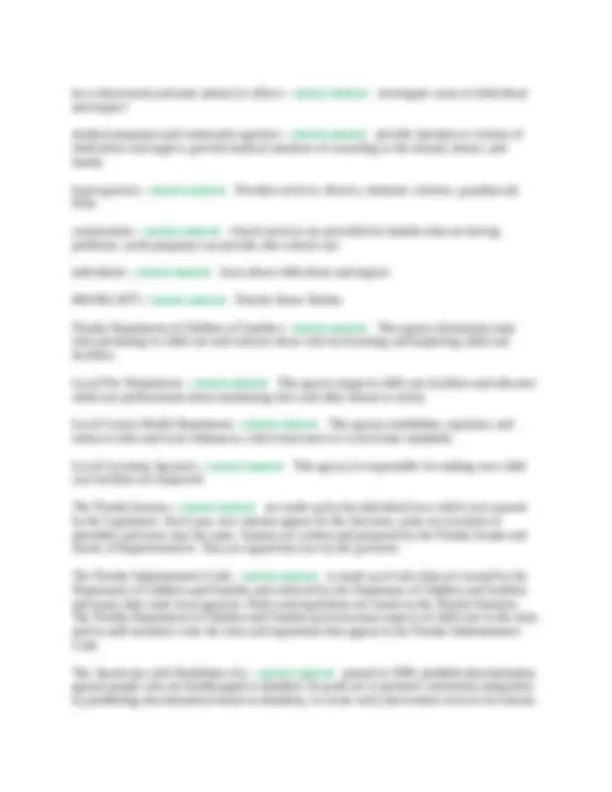
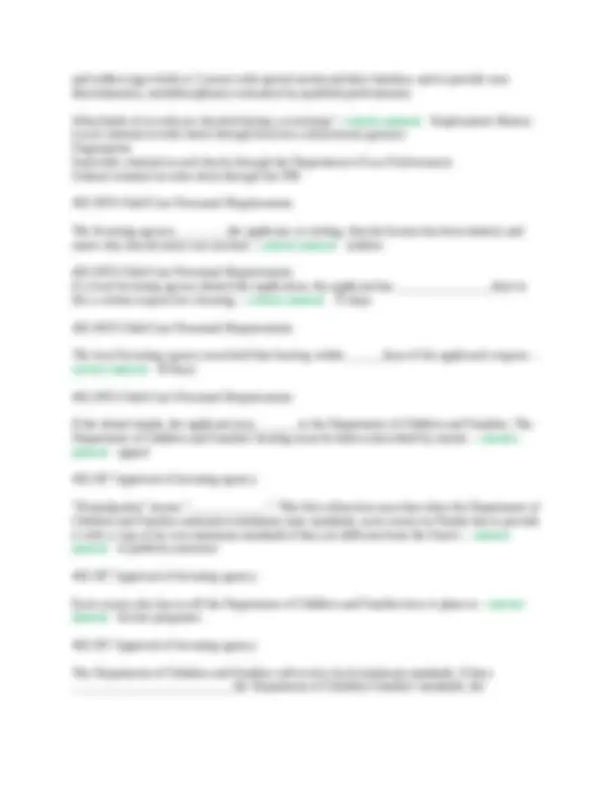
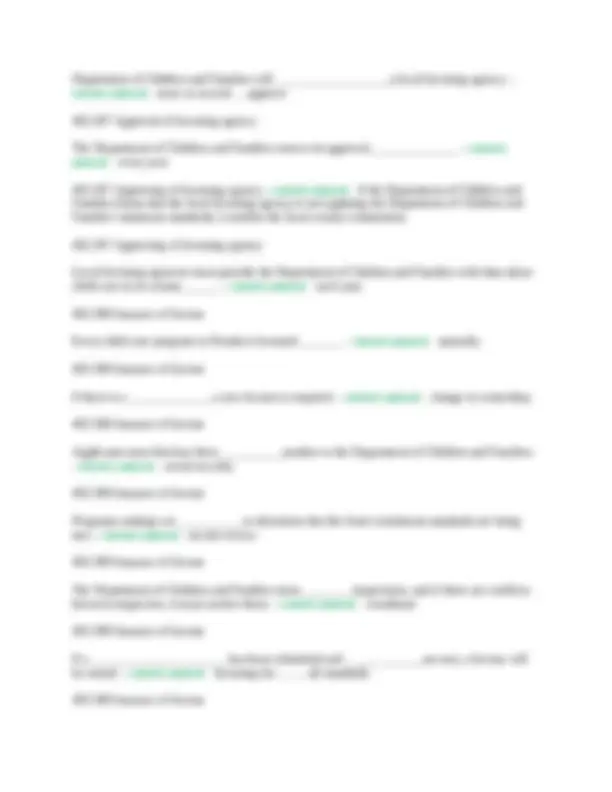
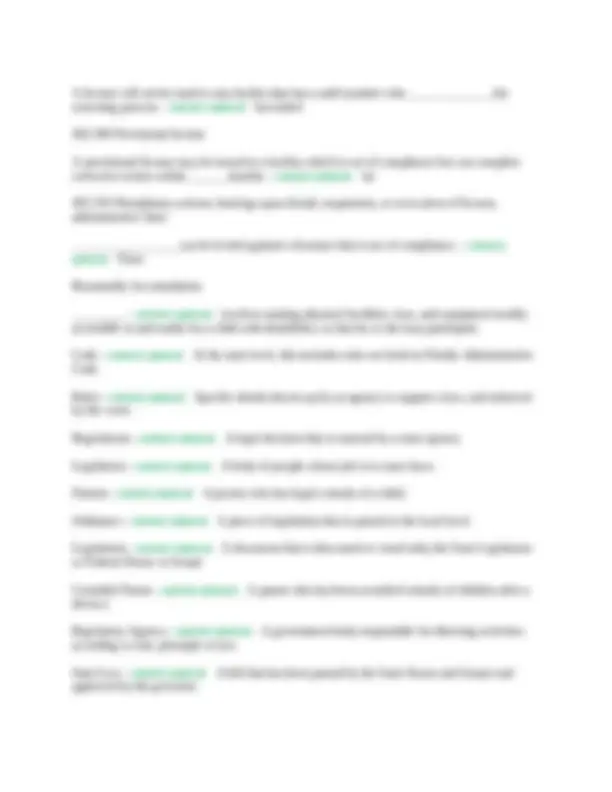
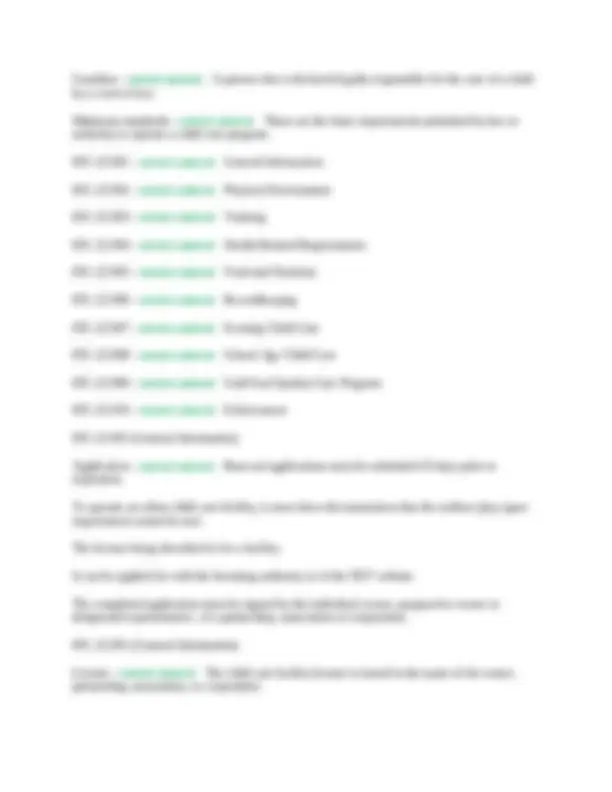
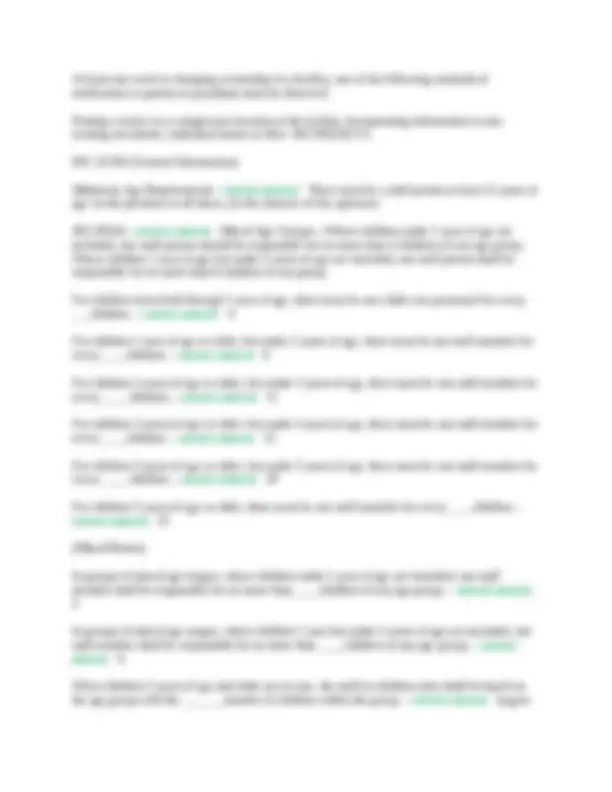
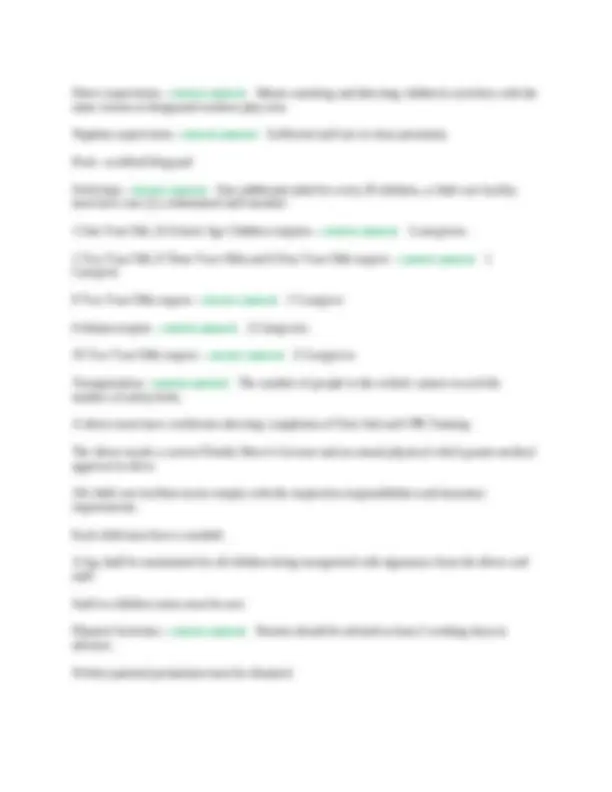
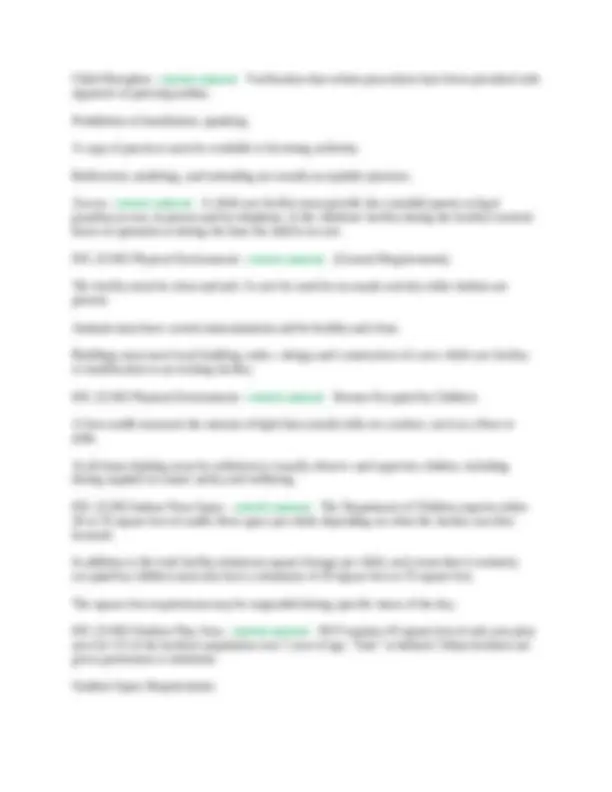
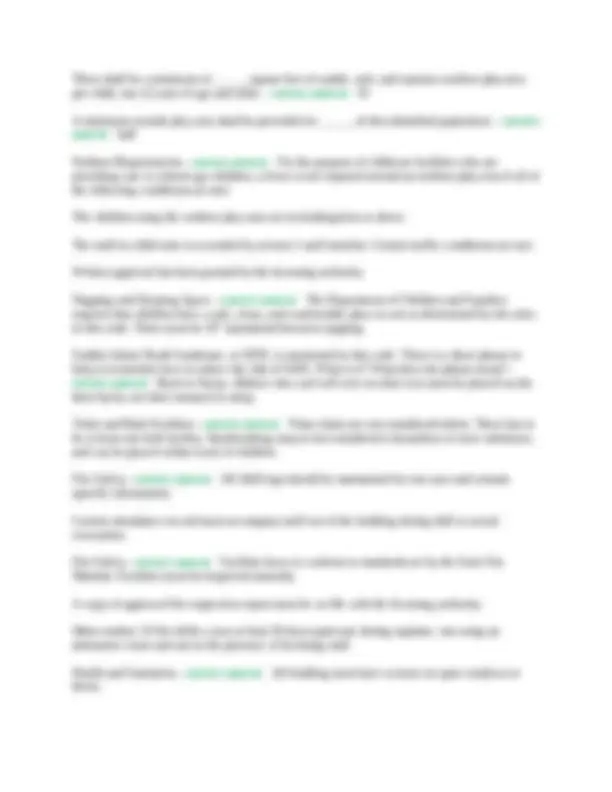

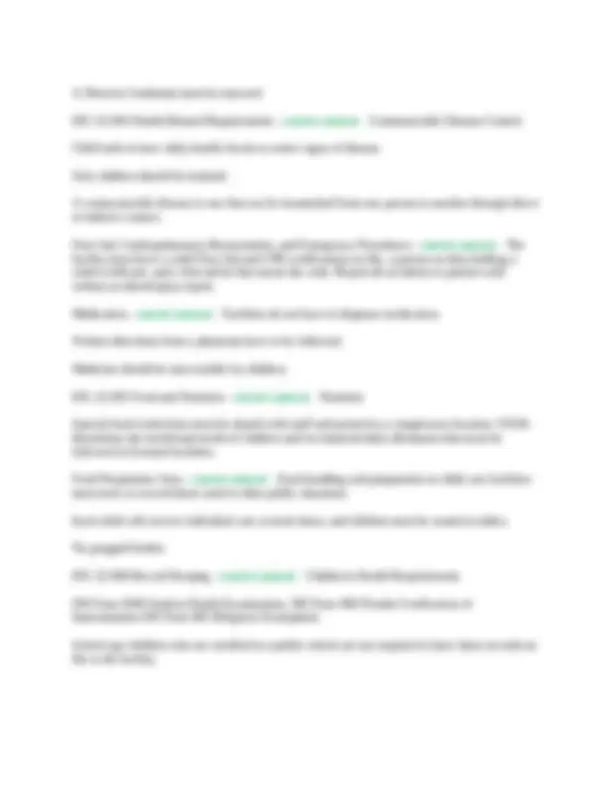
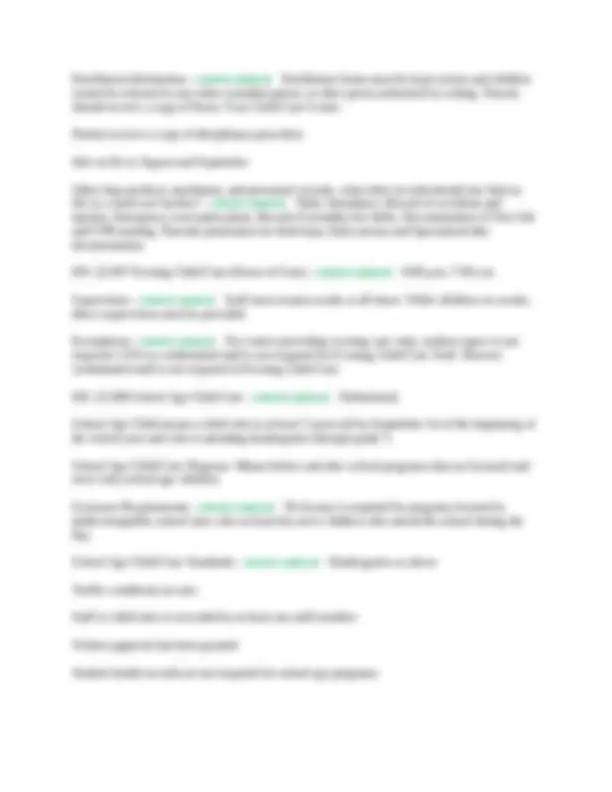
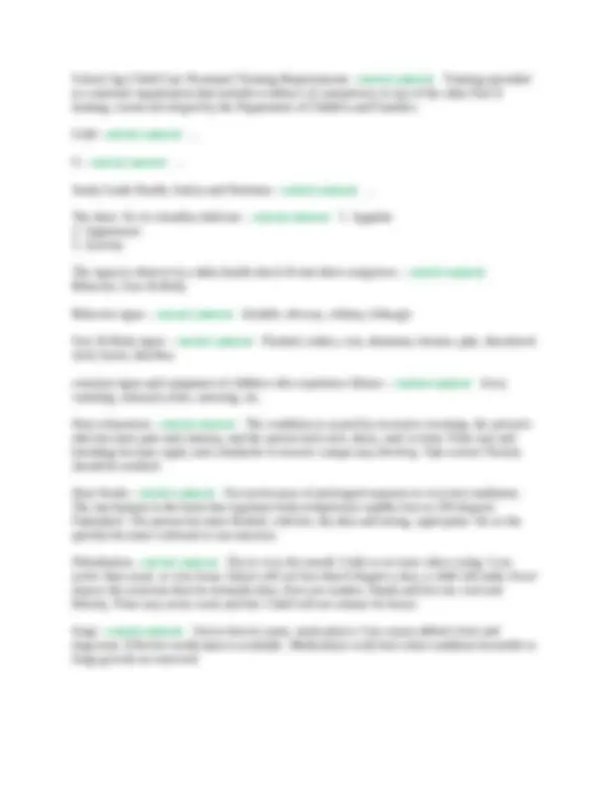
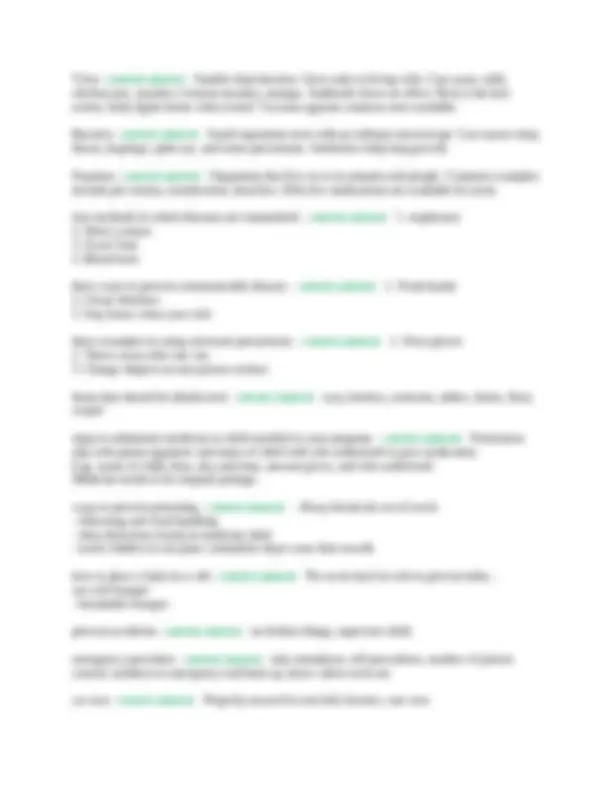
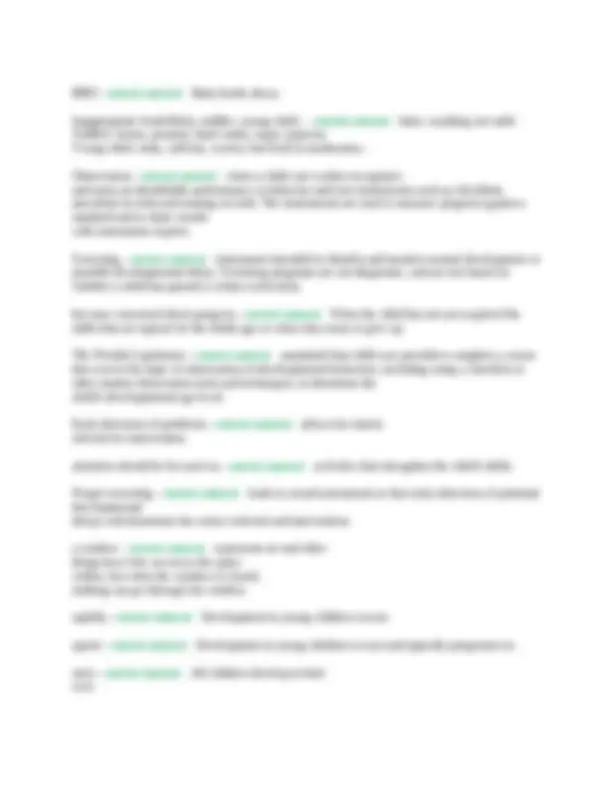
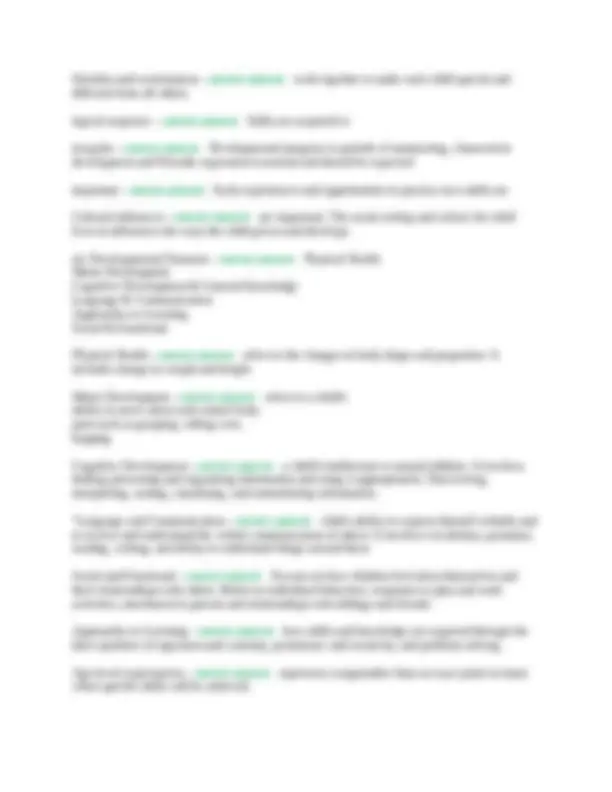
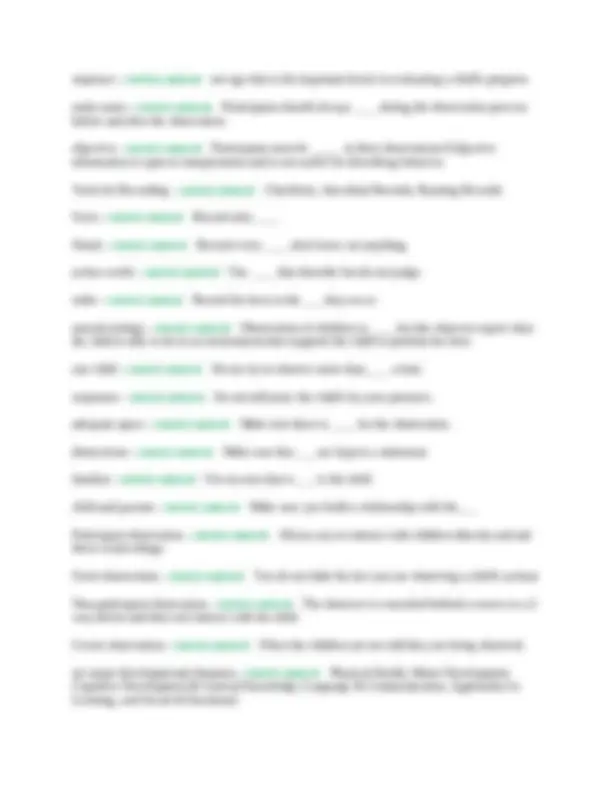
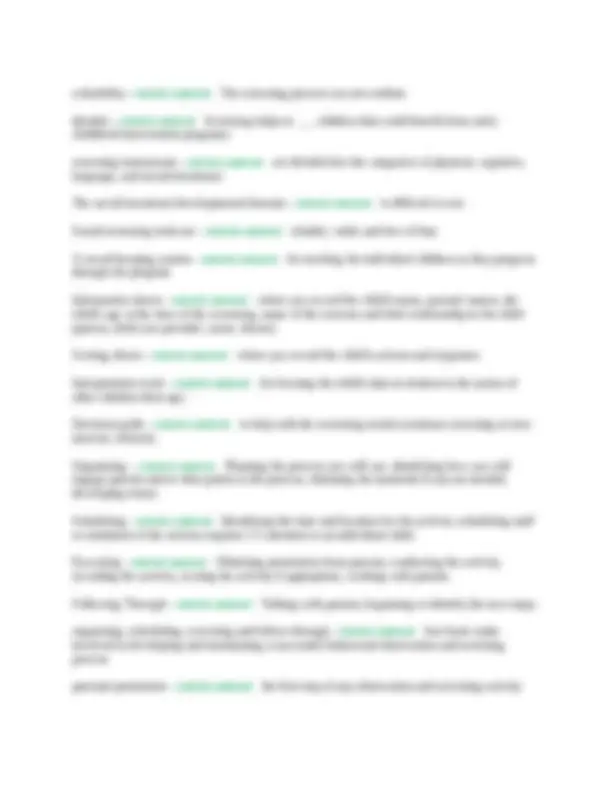



Study with the several resources on Docsity

Earn points by helping other students or get them with a premium plan


Prepare for your exams
Study with the several resources on Docsity

Earn points to download
Earn points by helping other students or get them with a premium plan
Community
Ask the community for help and clear up your study doubts
Discover the best universities in your country according to Docsity users
Free resources
Download our free guides on studying techniques, anxiety management strategies, and thesis advice from Docsity tutors
DCF Child Care 40 Hour Certification-Exam Graded A+
Typology: Exams
1 / 57

This page cannot be seen from the preview
Don't miss anything!


















































Why do childcare professionals observe and screen children? - correct answer So they can facilitate the growth and development of every child in their program, detect early signs of development, delay or disability, and identify signs of child abuse or neglect. Observation - correct answer an ongoing process in which child care professionals recognize and document identifiable developmental milestones as they appear using tools such as checklists, anecdotal records, and running records Screening - correct answer is an ongoing process in which child care professionals use specialized observation and documentation tools to identify, document, and monitor typical development or possible developmental delay Developmental milestones - correct answer are observable behaviors, traits, skills, or abilities that typically appear at specific age ranges 3 main reasons child care programs observe and screen children are to: - correct answer -foster growth and development
Natural Environment - correct answer places the child would typically be such as home, the child care program, school, rather than a directors office or doctors office. Developmentally Appropriate Practice - correct answer research based framework based on meeting children where they are individually, chronologically, and culturally Individualized Care - correct answer attention paid to a child that recognizes and adapts to his or her unique character and physical emotional, and cognitive traits. Screening Session - correct answer Trained adults identify and measure specific skills and abilities as indicated by a screening instrument Screening takes place - correct answer recurrently using an instrument that is proven to be valid, accurate., and reliable Family members involvement in screening - correct answer May be active or passive, but always involved Benefits of Screening - correct answer -identify specific areas of concern -determine if assessment or evaluation may be necessary -basis for referral -give info to parents to make decisions -open ongoing communication with parents and others Assessment - correct answer an agency or organization gathers and reviews multiple sources of info about a child's suspected or confirmed developmental delay or disability and uses data to improve a child's outcomes Evaluation - correct answer procedures used by qualifies personnel that determines a child's eligibility for federal, state, and local programs and services Role as a child care professional - correct answer Observation, Screening and Referral Guideline - correct answer general course of action taken to achieve a desired result Best Practice - correct answer specific action taken by experts in the field to achieve a desired result Guidelines for Observation and Screening - correct answer Be informed, objective and accurate, honest and fair, focused Objectivity - correct answer ability to set aside personal beliefs, values, opinions and biases, and consider only facts Subjectivity - correct answer involves the application of one's point of view when determining a course of thought or action
in regards to observation- refers to records that help identify a child who may be at risk of maltreatment, delay, disability or to relay a suspicion of child abuse frequency count - correct answer how often a behavior happens identify how often behaviors to be addressed or accommodated running record - correct answer write about what is happening while you are observing standardized test - correct answer compare a child's development to other children of the same age. ability to compare contrast, solve problems, classify objects, put things in order, arrive at conclusions tested time sample - correct answer document children's attention span. how much time they spend doing an activity work sample - correct answer observe a child's skill by using a product they have created can be 2d (drawing or writing) 3d (sculpture) could be a photograph or video of child building or recording of them singing or telling a story rating scale - correct answer used to measure behavior, skill, ability based on a series of quality points or a continuum Child care professionals do not - correct answer diagnose at risk - correct answer describe a condition or situation of vulnerability or of being in danger at-risk - correct answer before a person or thing that is vulnerable or in danger Individuals with Disabilities Education Act (IDEA) - correct answer Mandates that children with disabilities receive a free and appropriate public education (FAPE) Who is at Risk? - correct answer Males, living in poverty are at the highest risk for developmental delay or disability Developmental disability - correct answer chronic condition that is diagnosed in childhood and substantially limits major life activities in adulthood, and impacts a child's abilities to perform activities in one or more developmental domain Autism - correct answer a group of neurodevelopmental disorders characterized by social impairments, communication difficulties, and restricted and repetitive patterns of behavior Down syndrome - correct answer a genetic disorder characterized by distinct physical traits and intellectual impairments
Genetic disorders - correct answer conditions that are due to an abnormality in the way a body's cells are structures. if it is genetic it is present at birth, even if not diagnosed at the time Distinct physical - correct answer traits refers to similar facial and body features shared by people with down syndrome Intellectual impairments - correct answer means that people with Down Syndrome may have a difficult time understanding and processing info Self-help skills - correct answer are a wide variety of abilities that are useful in every day life. Also know as adaptive behavior or adaptive skills ADHD - correct answer a disorder characterized by impulsivity, inattention, and/or hyperactivity Cerebral Palsy - correct answer a disorder that affects body movement and muscle coordination Fetal Alcohol Syndrome - correct answer a syndrome characterized deformities in the joints, fingers, and limbs; atypical behavior, learning disorders; and cognitive impairment Autism Spectrum - correct answer a group of disorders characterized by social and communication impairments and restricted and repetitive patterns of behavior Cognitive Disabilities - correct answer disabilities that affects self-help skills and the way the brain processes info Fragile X Syndrome - correct answer a syndrome characterized by intellectual disability and behavior disorders, more prevalent and severe in males Bipolar Disorder - correct answer a disorder characterized by extreme mood swings and shifts in energy Phenylketonuria (PKU) - correct answer a disorder characterized by delays in motor development and seizures, it often appears in conjunction with a behavioral disorder The goal of the Infant and Toddler Appropriate Practices course - correct answer is to guide child care professionals responsible for the care of children birth through 36 months through the principles of developmentally appropriate practice. Infant - correct answer "infant" comes from the Latin word "infans" which means unable or incapable of speech. first stage of their life, until around 18 months of age.
The sensorimotor stage takes place from birth to age two. During this stage children explore their world using their senses and motor skills. They like to touch and hold objects and toys such as rattles, dolls, or soft books. They also tend to explore objects using their mouths. They begin to understand the world by physically manipulating objects, and through trial and error problem solving. Trust vs Mistrust - correct answer by Erikson This conflict is resolved when infants form bonds with their parents and caregivers and establish an emotional foundation through trust. As the basis for fulfilling the safety and comfort needs of infants, emotional security must be established through trusting relationships with adults. Children who do not experience positive, caring and loving attention from adults and caregivers can develop distrust for people around them and can result in poor emotional stability. Autonomy vs Shame & Doubt - correct answer by Erikson Stage 2 of Erikson's social theory deals with the conflict of autonomy vs. shame and doubt. This means that children need to be able to become independent and learn to problem solve on their own. As a caregiver you can encourage independence by allowing children to explore their environment in a safe and supervised manner. Children who explore and discover their environments will become confident about themselves and develop the ability to problem solve. Children also need to become aware of the physicality of their bodies. Engage children in games of pat-a-cake, tossing or rolling a ball, and manipulative toys that encourage children to use their hands. Install mobiles above infants' cribs to encourage them to look at and reach for the objects hanging down. 5 Areas Of Development - correct answer Physical Development Social and Emotional Language and Communication Cognitive Development and General Knowledge Approaches to Learning Physical Development - correct answer Infants Weight doubles in the first 6 months and triples by the 1st birthday. During this time infants require frequent feedings to aid in growth Infants grow 5 inches in length in the first 6 months and add 3 more by 9 months Toddlers Appear to grow slower than they did during infant stage Begin to walk without help Show interest in exploring their environment Begin to feed themselves and drink from a cup
Motor Skills (Fine and Gross) - correct answer Because infants and toddlers are not yet proficiently mobile or skillful at manipulating objects in the environment, they are developing both their gross and fine motor skills at the same time. Head to toe (cephalocaudal), meaning infants will learn to use their arms before their legs Center of body to limbs (proximodistal), meaning infants will gain control of their bodies starting from the torso and working outward to their arms Gross motor to fine motor, meaning children will develop large general movements such as waving their arms before they learn to grasp and use objects such as crayons Locomotion - correct answer the ability to move from one place to another, also develops along a pattern: 2 - 3 months - head and chest control 3 months - can reach and miss 5 - 6 months - rolls from back to stomach 7 months - sits alone 8 months - stands with help Motor SKills - correct answer Motor Skills are movements used to perform an action: 12 - 15 months - can stand alone and walk well 15 - 18 months - learning to walk backwards 18 - 24 months - throws a ball, jumps in place, becoming more physically able 24 - 36 months - learning to ride a tricycle, stand on one foot Social and Emotional Development - correct answer Birth - 3 months Able to calm down, enjoys touch, and alerts to sound of a voice. Unknown why infants begin to express a social smile. Some people believe infants are "prewired" to smile at this age. Others believe smiling earns positive attention so infants begin to smile more. Infants will communicate by cooing and babbling before they learn to speak, and will eventually begin to make sounds that imitate the language of their culture. Cooing is important to caregivers because it indicates that a child is beginning to practice conversation. Can participate in "conversations" by taking turns making sounds; for example, when a caregiver speaks to an infant the infant will wait until they finish a phrase and then "coo" in response. Some infants even engage in "cooing" conversations when they are in adjacent cribs; these infants will take turns cooing in a simulated conversation. 3 - 7 months
What affect does quality early care on children? - correct answer "...children who have high- quality care see academic benefits lasting into high school." DAP - correct answer Developmentally Appropriate Practice focuses on children birth to eight years old and is made up of three principle components: age appropriateness, individual appropriateness, and social/cultural appropriateness. Age appropriateness - correct answer considering what is typical for a child within a given age group. Individual appropriateness - correct answer considering the needs of each child as a unique individual. Social/Cultural appropriateness - correct answer considering the social and cultural contexts in which children grow and live. Intentionality - correct answer Studies show, highly effective teachers have clearly defined goals for children and they thoughtfully prepare environments, experiences and activities to meet those goals. Three critical challenges impacting early childhood practices are: - correct answer -Addressing differences in school success and achievement -Integrating and aligning preschool and elementary school programming -Improving teacher preparation, professional development and ongoing support Structural indicators - correct answer are things that are "regulable," meaning they can be monitored and are important for providing consistent care. EX: Licensure Lower ratios Smaller group size Caregiver qualifications Professional development for staff Health and safety regulations Inclusive environment Process indicators - correct answer are what programs "do" to help promote development through specific activities and intentional practices. Process indicators are observable interactions. EX: Curriculum and established routines Language and reasoning activities Sensitive, responsive interactions Collaboration and provisions for parents and families Parent, teacher, and child interactions
Child-sized furnishings Well defined and equipped space that meets the needs of all children Studies suggest quality experiences early in life lead to better outcomes for children. These experiences lead to: - correct answer Lower delinquency rates Increased graduation rates Adults who earn higher salaries Increased home ownership Better cognitive and language skills Adults who spend less time participating in social programs or on welfare Quality Preschool - correct answer Developmentally appropriate curriculum Developmentally appropriate assessment procedures Continuous staff training Administrative support Low teacher/student ratio Systematic effort to involve parents Quality Early Care + Quality Education = - correct answer Quality Outcomes for Children High Quality Child Care - correct answer High-quality child care is a safe, nurturing environment where children learn and grow. Staff are properly trained and supported. Parents have access to the program at all times and the program is well organized to promote optimal skill development. Motivational theories - correct answer focus on the belief that humans are controlled by many factors. They place more emphasis on personal motivation and desires than on what is happening in the environment. Based on these theories, you might consider what motivates children to act the way they do. Social development theories - correct answer focus on emotional and personality development. Psychosocial development helps children shape their personalities by strengthening their ability to successfully negotiate conflict during various stages. Each stage of development lays foundational patterns that influence a person's ability to resolve conflict throughout life. Intellectual/Cognitive development theories - correct answer focus on children developing an intellectual understanding of their world. Children interact with materials and people in the environment to construct knowledge. Children are naturally curious about the world around them and they learn best when they are stimulated and interested in what they are doing. Abraham Maslow's Hierarchy of Needs - correct answer This theory suggests children move through stages as certain needs are met. If basic needs are not met, children do not progress in development. Physical (Basic) Needs Safety and Security (Comfort)
Two developmental levels of ability: The ability to do something with help or assistance The ability to do something without help or assistance The distance between these two levels is called the "Zone of Proximal Development." Structure of a Neuron - correct answer Neuron - specialized nerve cells that make up the central nervous system. Axon - Each neuron has one axon. An axon is a fiber that sends messages "away" to other neurons. Dendrites - Each neuron has many dendrites. Dendrites accept incoming messages from the axons. How many neurons are in a brain at birth? - correct answer When a child is born, there are already nearly 100 billion neurons in the child's brain. Physical Development - correct answer Physical development refers to the development of large and small muscles as they gradually develop. It involves typical growth patterns, changes in weight and height, and general health and safety. Art Progression - correct answer Children will typically progress from drawing free radicals into drawing basic shapes, such as circles, squares, rectangles, and triangles, then eventually drawing representations of people, places and ideas. By the age of three, children should begin to draw their first representations of the human form using basic shapes. free radical - correct answer is a jumble of straight or curved lines that is freely floating on the paper. Writing Progression - correct answer Writing begins to emerge as random scribbling and progresses to invented spelling in the kindergarten years. With enough opportunities to practice scribbling and writing, and with enough encouragement and enthusiasm from caregivers, children learn to write with increasing effectiveness and also understand the importance of written communication. Mildred Parten Four types of play - correct answer Solitary play - playing alone Parallel play - playing beside other children, but not interacting with them Associative play - children play together with materials and some talking (3-5 years old) Cooperative play - children play together by planning and working toward a common goal ( years old through adolescence) Stages of Development - correct answer Stages of development for young children are commonly clustered into domains related to physical development, language and
communication, social and emotional, cognitive development and general knowledge, and approaches to learning. Classroom Structure - correct answer Children are better able to adapt to the demands of formal schooling when they have been provided opportunities to explore and practice within an environment that is consistent and predictable, yet flexible and inviting. Classroom Structure should include - correct answer -Furniture for routine care and play should be child sized. -open shelves, baskets and cubbies should be placed on the child's level so they can easily reach them. -printed words that are meaningful and at a level where children can easily see them. -Children's art and writing samples should be displayed around the classroom at the children's eye level. Interactive Learning Centers - correct answer -Dramatic Play/Home Living: kitchen furniture, mirrors, dress-up clothes, baby dolls, tables/chairs -Library: books, cozy area/ listening center, rugs, puppets, soft pillows/furniture, natural lighting -Discovery/Sensory/Science: items found in nature (pine cones, shells, rocks), water/sand table, sensory items (shakers, smelling jars) -Blocks/Construction: wooden/plastic/cardboard blocks, trucks/cars, doll house -Art/Creative Expression: paper, paints, pencils, markers, pens, collage materials, brushes, easels -Music/Movement: records, tapes, CDs, musical instruments -Manipulatives: pop beads, stack/nesting toys, puzzles -Wood Working: tools, Styrofoam, glue, toy hammer/nails -Feeding Area: tables/chairs, utensils, garbage can, sinks -Sleeping Area: individual cots, blankets, transitional objects, sheets, soothing music, dim lights -Writing Center: pencils, crayons, markers, dry-erase board, paper, sticky notes, erasers, stamps -Parent Communication Board Room Arrangement - correct answer -Exits clearly marked -Remove clutter and eliminate blind spots -clear pathways that allow for smooth traffic flow in and out of each area -Keep toys and supplies on low, open shelves with picture and word labels that are appropriate for the children's age and abilities -Traffic patterns should be set up to avoid large open run-ways, yet should not be so divided up they are hard to move around in. Good room arrangements foster positive relationships and interactions by creating a homelike atmosphere that is inviting and culturally representative. Room Arrangement Tips - correct answer Easy movement between centers is encouraged when like centers are placed near each other. Messy play areas, such as art, sand and water, should be placed near each other and should be convenient to a water source to facilitate setup and cleanup. Quiet, clean areas, such as books, manipulatives and computers, should be physically placed away from the messy areas.
Girls enter puberty between - correct answer 8 and 13 Boys enter puberty between - correct answer 10 and 15 Growth proceeds - correct answer head to toe center out Children gain control of __________ first, then arms and legs - correct answer head and neck Are the brain, heart and spinal cord fully functioning at birth? - correct answer yes As children grow they gain control of their arm and leg muscles, then finger and toe - correct answer Gain control of big, general muscles then refine the skills Principles of Child Development - correct answer 1) Sequence is similar for all
down syndrome - correct answer a genetic disorder that results in a number of physical characteristics and intellectual impairments Prevention - correct answer stops challenging behaviors before they begin Redirection - correct answer used to guide children's behavior by recognizing challenging behavior at its earliest stages and taking steps to stop it from escalating Positive Reinforcement - correct answer desired behaviors are rewarded so that the child is encouraged to repeat them Theory - correct answer a set of facts or principles analyzed in relation to one another and used to explain phenomena (a fact or behavior that can be observed) Abraham Maslow - correct answer Hierarchy of Needs Erik Erikson - correct answer 8 Conflicts in Emotional Development (ERIKSON has 8 letters, E stands for emotional = the emotional 8) Jean Piaget - correct answer 4 Stages of Cognitive Development (Jean has 4 letters) Sensorimotor - correct answer sensory perception 0- PreOperational - correct answer thinking is based on how things are perceived rather than logic 2- Concrete Operational - correct answer thinking is rational 7- Formal Operations - correct answer thinking becomes abstract 11+ Lev Vygotsky - correct answer Sociocultural Theory of Cognitive Development Think of Victor on a bicycle. As he learns to ride he has help at first and then less as he becomes more skilled. Adults and other children help him learn. Heredity - correct answer passing down of genetic characteristics from parents to their children Temperament - correct answer prevailing or dominant quality that characterizes a person
Neglect - correct answer Failure to provide adequate food, clothing, shelter, health care or needed supervision Emotional Neglect - correct answer Failure to provides support, acceptance, attention, warmth, supervision, and normal living experiences for a child to the extent that the child is impaired in ability to function normally in performance and behavior Harm - correct answer Anything to a child's health or welfare that can occur when any person a) inflicts or allows to be inflicted, upon the physical, mental, or emotional injury. b) commits or allows to be committed, sexual battery or lewd, or lascivious acts against a child Inadequate Supervision - correct answer When a child is left alone in a situation beyond their physical and emotional development level or when a child is left in the care of someone who does not provide adequate supervison
Immunizations - correct answer Administration of a vaccine to make the body build up a defense against a disease Clean - correct answer To remove dirt, debris, and germs by scrubbing and washing with soap (or detergent) and water. The process does not necessarily kill germs, but lowers the risk of spreading infection. Disinfect - correct answer To kill germs on surfaces or objects by using chemicals to lower the risk of spreading infection Vaccine - correct answer A group of substances that produce immunity to disease in a person Communicable Disease - correct answer Disease that can be spread from one person to another Evacuation Plan - correct answer Procedures for getting children and staff out of a building; applied during the fire drills and any other emergency Isolation Area - correct answer A designated area for a child who becomes ill at a facility Daily health checks are a good way to - correct answer Prevent, Identify, and Control illness in a child care environment What is a theory? - correct answer A set of facts or principles analyzed in relation to one another and used to explain phenomena(a fact or behavior that can be observed) How do you create a positive environment for children in your care? - correct answer *Ensure learning centers have ample space for movement. *Reduce the number of transitions throughout the day. *Ensure the environment feels safe for the child. *Provide activities that are slightly challenging to the child. *Provide activities to increase development without causing frustration. Abraham Maslow developed what? - correct answer The hierarchy of human needs How many levels does Maslow's hierarchy have? - correct answer Five What are the 5 levels of Maslows hierarchy? - correct answer Level 1-Physical Level 2-Comfort and Saftey Level 3- Social Level 4-Self-esteem Level 5-Self-Actualizing What are examples of a Physical need? - correct answer *Air to breathe *Shelter to protect *Water to drink